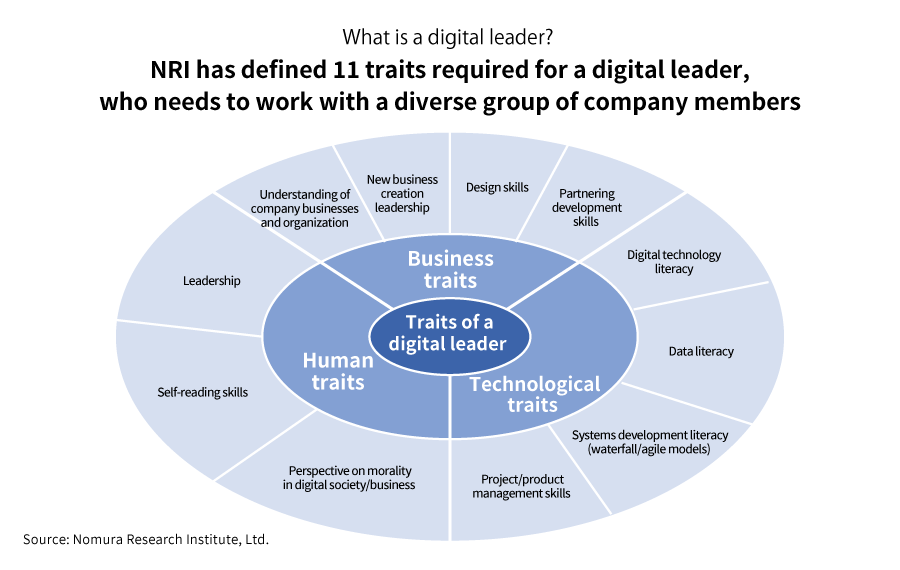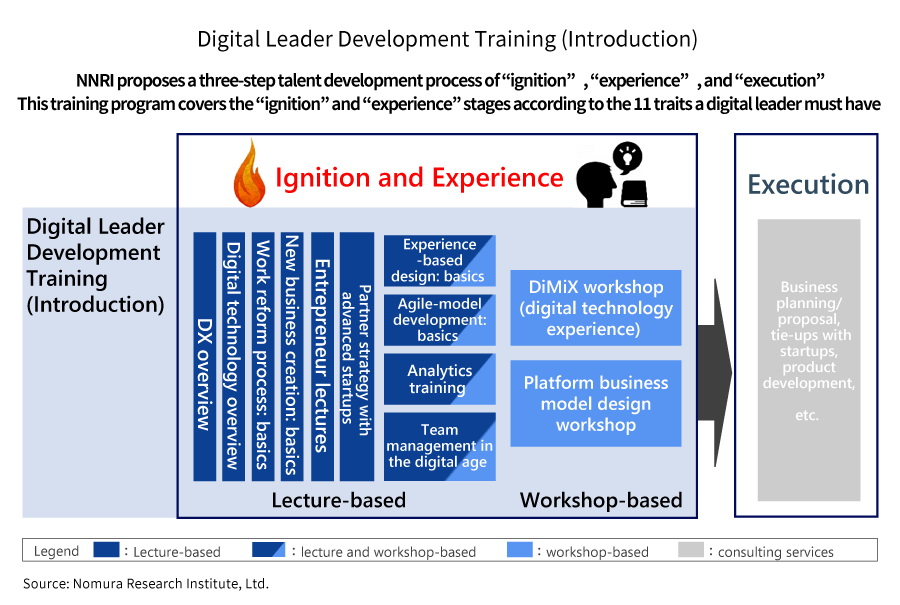
Three Steps to Developing Digital Talent: In-House Talent Essential to Successfully Compete in the Digital Age
To achieve a successful digital transformation (DX), companies must do more than just having digital-technology-savvy talent onboard. The key is having “digital leaders” who are well informed about company businesses and rules and who are capable of engaging various internal stakeholders and promoting DX measures in day-to-day operations. We asked Hiroki Nakagawa and Mari Kinooka of Nomura Research Institute (NRI) how to develop such talent.
Identify prospective digital leaders in-house
--- When promoting DX, do many companies feel they have challenges with human resources?
Kinooka: In the past we received many inquiries about what to achieve in DX, but I feel that over the past year or two, companies have moved to the execution phase and they are paying more attention to digital talent. The “2020 Survey on Digitalization Initiatives” that NRI conducted jointly with the Japan Users Association of Information Systems (JUAS) also found that, when asked to name “factors considered important in promoting digitalization”, many respondents said “reaching a decision/agreement and/or leadership to take action when the resulting effect is uncertain” (73.8%) and “securing a new type of digital talent” (54.4%).
When thinking of digital talent, some companies focus on data scientists with data analysis skills, full-stack engineers who can build systems swiftly, and other so-called tech specialists, and they seek to procure external talent by paying hefty fees. Such efforts are important, naturally, but the point we want to drive home is that merely bringing in tech talent does not equate to successfully promoting DX.
Nakagawa: In the first place, without understanding the businesses and operating processes at your company, you cannot generate ideas for leveraging digital technology that will be beneficial for the company. It is critical to develop “digital leaders”—who can engage senior management and relevant divisions, serve as a bridge connecting them and build consensus, and implement digital strategies straightforwardly—from among internal personnel who are well-versed in company rules and culture.
Three-step development: “ignition”, “experience”, and “execution”

--- Is there a good way to develop such talent?
Kinooka: We at NRI are proposing a three-step talent development process of “ignition”, “experience”, and “execution”.
Digital leader candidates tend to have experience succeeding in an existing business and a low level of interest in or motivation for engaging in new digitalization efforts, with some even having negative thoughts about it. This is why, at the “ignition” stage, we will ensure that they understand what would happen if they don’t pursue digitalization and turn on their “digital mindset” to spur interest and motivation.
The “experience” stage offers off-the-job training, where prospects will master necessary knowledge and skills. NRI has established 11 traits that digital leaders must have in the three categorized fields of “business”, “technology”, and “human”. This means that they need quite a broad scope of knowledge and skills. Companies need to provide an effective training program, where prospects learn basic knowledge in a short period of time and gain simulated experience in planning and execution, for example.
In the “execution” stage, they will participate in a real project for on-the-job training to promote growth through execution. Companies also need to assign mentors and take other steps to create a support structure so that this will be a meaningful place for growth.

All-online training incorporating knowledge from day-to-day operations offered
--- What type of support does NRI provide?

Nakagawa: Besides providing consulting and project collaboration, we carried out a trial program of “Digital Leader Development Training (Introduction)”, which covered the “ignition” and “experience” stages, over a period of four half-days in September 2020. To ensure that the program covers the broad scope of the traits that a digital leader must have, we not only brought together the NRI group’s intelligence but also tapped the expertise of external specialists. It was initially supposed to be an on-site training program, but the coronavirus restrictions suddenly forced us to switch to all-online training.
The trial program was attended by nearly 30 people from companies in a wide range of industries, and used the workshop tool Mural, various Zoom functions, and on-demand streaming. This also allowed us to learn key points of virtual meetings, such as time allocation and assigning breaks and a social hour.
Kinooka: Based on our self-assessment of the trial and feedback from the participants, we have created an introductory training package. Right now we are considering offering an intermediate-level training program that chiefly covers the “experience” stage. We’ll continue pursuing training in NRI’s signature style, with lecturers with experience discussing real situations on the ground that are not mentioned in a textbook or going over points that tend to be mishandled, for example. We’d also like to provide post-training support in various ways, such as development of actual products and concept proposal.

--- Lastly, what advice do you give to companies facing a digital talent challenge?
Kinooka: Organizations and companies are human creations . Discussing with senior management what digital talent your company needs—in terms of what skills, knowledge and experience they need to have—will be the first step in hammering out a human resources strategy in the digital era. Upon doing so, it is important to think outside the box and overhaul areas such as hiring, talent development, and workplace environment one by one patiently.
Nakagawa: Personnel issues are not easy to deal with because they include compensation, promotion and other sensitive matters, and that’s a fact. But for companies that keep using the same hiring and talent development methodology, it is becoming more difficult to acquire skilled talent. It is critical to tackle this issue “now” especially if you don’t want to fall behind digitally advanced companies.
Profile
-
Hiroki Nakagawa
-
Mari KinookaPortraits of Mari Kinooka
IT Management Consulting Department
At NRI since 2018, she focuses on global IT management strategy and digital talent development.
* Organization names and job titles may differ from the current version.